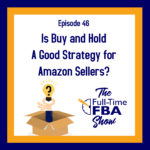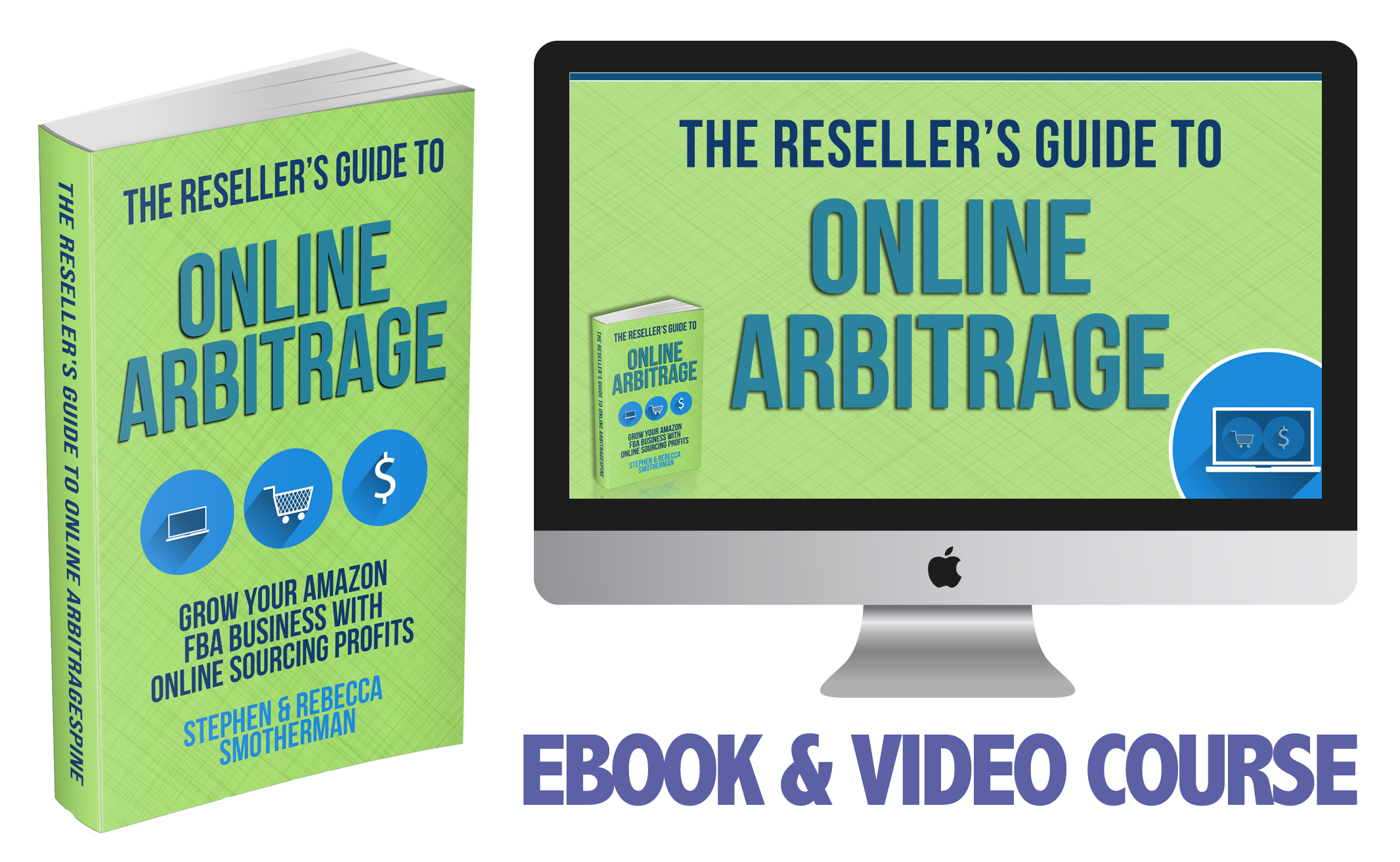In this episode, we dive into the buy and hold strategy, which is basically buying products now in order to hold them to sell at a point in the near or distant future. Sometimes a reseller will find an item that is not profitable now (or that could be even more profitable in the future) and might be tempted to buy the items now to sell them some time down the road.
Maybe you found an out-of-season item that might be profitable when it comes in season, or maybe you found a product you know will be harder to find 9 months from now (and therefore might be worth more to sell later)… so is buying and holding the best strategy to maximize your profits? We’ll discuss all the pros and cons of this buy and hold strategy today on The Full-Time FBA Show.
Listen on the podcast player below.
Like what you hear? Tell a friend… and be sure to leave us a rating and a review. Here’s how.
Key points from episode 46:

- What the buy and hold strategy involves and the reasons why people might use it.
- Why this strategy might not be worth risking your capital on.
- The hidden costs of the buy and hold strategy
- The various risks involved in keeping your inventory at home.
- How the opportunity costs figure into your decision to use the buy and hold strategy or not.
- The best times that it might be appropriate to use the buy and hold strategy.
- And more!
Links and resources mentioned in this episode:
- Understanding Your IPI
- How to Improve Your IPI
- More Amazon FBA Risky Strategies to Avoid (blog post)
- More Amazon FBA Risky Strategies to Avoid (podcast episode)
Right-click here and save as to download this episode to your computer.
 More Episodes from the Full-Time FBA Show podcast:
More Episodes from the Full-Time FBA Show podcast:
Don’t miss an upcoming episode! Subscribe, download episodes, and review the Full-Time FBA Show:
-
-
- Subscribe on iTunes
- Follow on Spotify
- Follow on Amazon Music (or just ask Alexa to “play The Full-Time FBA Show podcast”)
- Follow on iHeartRadio
- Subscribe on Podbean
- Subscribe on Podbay
- Subscribe on Podchaser
-
![]()
FINALLY MASTER ONLINE ARBITRAGE
If you want to add or improve your existing online arbitrage (OA) sourcing skills, then check out our course: The Reseller’s Guide to Online Arbitrage: Grow Your Amazon FBA Business With Online Sourcing Profits.
The course is a combination video course (5+ hours of OA training) and a 100+ page ebook. The videos and book both share the exact same content (so you can pick the format you most like to learn from). The course also comes with six time-saving and money-making bonuses all at no additional charge!
![]()
Back to the main page for The Full-Time FBA Show
![]()
Episode 46 Transcript:
 [INTRODUCTION]
[INTRODUCTION]
[0:00:01.8] ANNOUNCER: Welcome to The Full-Time FBA Show. In each episode, it’s our goal to help you turn part time hours into a full-time income, selling almost anything on Amazon. Now, your hosts of the show, Stephen and Rebecca Smotherman.
[INTERVIEW]
[0:00:21.3] STEPHEN: Welcome to episode number 46 of The Full-Time FBA show. I’m here with Rebecca as always, Rebecca, how are you doing?
[0:00:28.4] REBECCA: I’m doing great.
[0:00:29.5] STEPHEN: That’s awesome, well, I want you to know that I am delighted, I am eager, I’m enthusiastic, I’m thrilled, stirred, moved, beside myself, I am fired up and pumped up and juiced up for this episode.
[0:00:42.2] REBECCA: Wow.
[0:00:44.9] STEPHEN: Thanks for the –
[0:00:46.2] REBECCA: I was not expecting that.
[0:00:47.9] STEPHEN: Yeah, thank you for giving me a thesaurus, we just say we’re just always excited about each episode.
[0:00:51.9] REBECCA: I did not know that was coming.
[0:00:54.1] STEPHEN: I was just going to mix things up a little bit but I am looking forward to this episode and we’re going to be talking about a strategy that some Amazon sellers try to do, it’s called buy and hold, we’re going to talk about if it’s a good idea or if it’s a bad idea.
[0:01:11.4] REBECCA: All right, well Stephen, put down that thesaurus and talk to us about the buy and hold strategy. Before we even get into whether or not it’s a good strategy, give us a little bit more detail about what this strategy actually is.
[0:01:24.3] STEPHEN: A buy and hold strategy is when you buy something and hold on to it for a long time. In order to sell it later, maybe when the price is higher and so maybe it’s march or something and you find an item that might sell really well during Christmas, well, do you buy it in March? Hold on to it and then send it in around Christmas time? Or do you go ahead and send it in now and hope it sells maybe sooner but it’s probably going to be until Christmas that it sells or maybe you’re going to buy something that will go out of stock in the future and you’re going to just buy it and hold it, waiting for that particular item to no longer be in production so that you can come out and sell it at a higher price.
It’s just a different way to resell stuff but there’s some pros and cons to that issue.
[0:02:07.6] REBECCA: Okay, well, I’ve got some other questions on that. First, before I get into those other questions. I’m assuming this isn’t like your favorite strategy based on kind of how you’ve set this up along the way that this is not something you’re going to recommend for like on a regular basis to use the strategy. Talk to us about why that is.
[0:02:26.5] STEPHEN: Yeah, I don’t like this strategy at all. The way I phrase it and even as we teased the next week’s podcast on last week’s episode, you said my face like dropped when I was even asking about it like my countenance just dropped, is it even a good idea? I don’t think it’s a good idea and there’s three reasons why I don’t think it’s a good idea to buy and hold something.
[0:02:50.0] REBECCA: Okay, get into those reasons for us then. What is the first reason?
[0:02:54.4] STEPHEN: The first reason is I think it’s a risky strategy. I mean, there’s no guarantee that the price will be higher in the future. I really think that it’s just a better use of my sourcing capital to focus on something that’s going to sell sooner rather than later. I know that with any type of business model, there’s going to be risks and you kind of want to pick and choose which risks you think are worth taking in relation to the return on investment of what – the risk that you’re going to take.
Without there being a guarantee, I don’t want to risk just holding up money, tying up money, tying up that capital in something that I hope will sell some day in the future. I know there’s people out there who by Lego sets and I want all of them for two or three years because at that time, you can’t find them in stores, you can only find them online and you can sell them for four times as much, potentially, but is that really the best use of your capital?
I really think it’s a risky strategy.
[0:03:52.5] REBECCA: Yeah, because you’re just banking on that actually happening, you don’t know that it’s going to be discontinued, you don’t know that the supply is really going to go down, you don’t know that the demand is going to stay high. It is a risk.
[0:04:03.5] STEPHEN: Yes.
[0:04:04.5] REBECCA: Okay, first reason is it’s a risky strategy, what’s the second reason that you don’t’ use the buy and hold strategy?
[0:04:11.9] STEPHEN: Second reason that I don’t like to buy and hold strategy is storage costs. Now, there’s two different types of storage here. If you are an FBA seller, you like to send your inventory to be stored in Amazon so you don’t have all that inventory in your house, that has different types of fees they can totally add up, there’s monthly storage fees, there’s Q4 storage fees which are usually about four times as much as monthly storage fees.
January through September, you have monthly storage fees, October through December, Q4 storage fees and then if it’s there for a really long time, you got long term, you got long term storage fees. That is a monetary reason why it’s not a good idea to send those items to Amazon because you’re just going to be sending, what are you going to do, price it really high and then Amazon gives you a high priced notification and it’s just a mess, it’s not really worth your time, plus you’re lowering your IPI score and if you want more information about IPI, you can go to fulltimefba.com/improvemyipi and you can learn more about that. But, if you’re just having stuff at stored at Amazon that’s not going to sell any time soon, that’s going to ruin your IPI score and will cause you to potentially to have storage limits at FBA.
On top of that, now, you might be saying Stephen, I just put it in my garage, I just put it in the attic, I’ll put it in a storage facility, you know, storage facilities will cost money but putting something in your attic or your garage or under your bed, well, if you decide to hold it at home, there’s also risks there.
There’s risks of forgetting about this, I will never forget the time that I was going into my attic and I found a box of Christmas themed plush and it just became December and I was like, I don’t know if I can get these fast enough to sell out. I had a ton of Christmas plush, I don’t know if you remember it was a bunch of curious George with a Christmas lights wrapped around him.
[0:06:00.8] REBECCA: My goodness, yeah, I remember that one. It was really cute.
[0:06:02.3] STEPHEN: It was and we kept one for our kid.
[0:06:04.1] REBECCA: It was in the attic just up there with everything else, it’s in our attic and we’re not in the attic every day to see that kind of stuff.
[0:06:09.9] STEPHEN: No, it’s out of sight, out of mind, so that you risk even missing the opportunity to sell an item in season by just holding it in your garage or your attic or under your bed, those storage costs both financially and losing that opportunity to sell it, it can be expensive and again, focus the best way you can run an Amazon FBA business for long-term success is focusing on items that will sell quickly and as soon as possible.
[0:06:39.8] REBECCA: I would like to add to that second point on this one that you’re also, you add some of the cost of just, the wear and tear on your relationship with whoever you’re living with and just you know, how you’re using this space in your house.
If you have a dedicated space for keeping inventory that you know, everybody that has any type of say over that in the house agrees too, that’s one thing but I remember early on in our marriage, we had inventory in places that drove me crazy, especially before – even before we got married.
[0:07:10.2] STEPHEN: Yeah.
[0:07:10.9] REBECCA: His garage, when we were dating was to me, just a nightmare and it really can take a toll on your relationship especially if you don’t have a supportive partner. If you’re keeping inventory to hold and sell later. It’s one thing to like bring inventory in and get it out really quickly but if you’re just storing something under the dining table because you think it will sell next Easter, that can be pretty harmful to a relationships. Be mindful of that kind of cost as well.
[0:07:41.9] STEPHEN: Yeah, many years ago, Amazon was at a place where most people did sell long tail items, long tail items is kind of what we’re talking about, items that you buy now and it takes a long time to sell them but the ROI is worth the weight.
And it worked many years ago back before there was an IPI and before there were long-term storage fees and things like that. So, if you are an Amazon seller who is still using that strategy, Amazon is trying to get you to switch your strategy to be focused more on fast turns because Amazon does not want to have their FBA warehouses be long term storage solutions. They just want their items there quick enough to be able to be sold on Amazon head right back out.
[0:08:28.5] REBECCA: Honestly, they want them to be fulfillments and there’s not warehouses, not storage units. All right, so the first reason for not using the buy and hold strategy was that it is risky. The second was that the storage cost can be expensive. What do you have as your third reason for why you don’t use this strategy?
[0:08:43.5] STEPHEN: So my third reason is the biggest one, this is the one, in fact this could be the only reason that I decide not to do a buy and hold strategy because it is so powerful. The third reason I do not do a buy and hold strategy is that the opportunity cost are just too high. A good definition of opportunity costs is the opportunity you miss out on because of a certain decision. So because you’re deciding to do A, you miss out on the opportunity of B or C or other options that are available.
And so that happens with everything. You want to make the best decisions possible and whatever decision you chose, you are going to miss out on opportunity. So you want to pick the best opportunity and again, we keep talking about this before, the best opportunity to grow a long term successful Amazon business is to focus on fast turns. Just holding out for hope that you’ll be able to double your money or triple your money long term down the road, it is just not worth it.
You always want to make sure that you choose the best opportunity that is out there and for me, to play in the long game when it comes to selling items is not the best opportunity. So here is an example, say there’s somebody who wants to buy a $20 toy and it is January and they’re going to think, “I am going to hold onto this. I think this is a Christmas themed toy. I am going to hold onto it until next Christmas and so I am going to spend $20 on this item and not going to sell it or send it into Amazon until November.”
So you’re saying that you are going to take $20 and hold up that capital in that particular item for months and months and months. You know almost a full year, you are going to be waiting to get that return on investment, whereas someone else could use that same $20 and buy something that will sell two weeks from now. They will get that money, the original money back plus their profit in which they can buy more products to sell and get paid for that.
And then take that higher percentage of amount of money to buy more products and see it grows overtime like a snowball and so that same $20, yeah you might be able to sell it for $60 in November or December but you could also turn that $20 over and over and over and over again each month and end up with $300 on being able to turn things faster and so that is what I am talking about when I say opportunity cost. You don’t want to hold up that capital in something that is not making you money.
[0:11:09.0] REBECCA: And then multiply that $20 times however many of those items that you are buying with it. You are not just buying one $20 item and then waiting for your $300 by the end of the year. You are talking many, many items thousands of dollars by the end of the year that you could be missing out on from holding you know one batch of $20 items for that amount of time.
[0:11:32.8] STEPHEN: Yeah. It adds up.
[0:11:34.2] REBECCA: All right, so there we have our three reasons why you don’t use the buy and hold strategy, why Stephen does not use the strategy. It is a risky strategy. The storage cost can be expensive and also the opportunity costs are just too high. So are there are times that you would use a buy and hold strategy? I know it is not your preferred method but are there times that you would consider using it?
[0:11:57.1] STEPHEN: The times when I am most tempted to use the buy and hold strategy are times where it is not a really long time of a hold. It is more of a short term hold. So maybe it is August or September and I know that there is an item that will sell really high for twice as much. I mean like for example there is board games that I know that come November and December, the price is usually triple and so if I decide to spend money on something in August or September, then I am going to wait until November and December.
Because usually I wanted to buy items that sell within 30 to 45 days that is my goal but I will extend that and that would be my own version to buy and hold. That might be other people’s normal strategies is the more you learn on Amazon, about selling on Amazon, the more you can be able to sell items that sell much faster than that but you know that is one time I am tempted to. Another time that I am tempted to is the rare times where I have more money than time.
And so if it doesn’t matter that money is tied up because I don’t have time to do this very often. You know I might do a long term hold because I still have money to source and I have still find more stuff to source with the money that I have. If you have more money than time, maybe it is something that could work for you.
[0:13:10.5] REBECCA: Yeah that was one of my other questions was doesn’t a lot of this come back to how much money do you have available to you. If you have a lot of capital available, you are going to make different decisions than if you just have a little bit of capital available.
[0:13:22.8] STEPHEN: Exactly, yes.
[0:13:24.8] REBECCA: All right, well does that about wrap this topic up?
[0:13:27.3] STEPHEN: Yep. So hopefully I have scared you away from doing buy and hold and if you decide to do it, you know you’ve been warned and you’ve been told the time is where I think it might work but you know what? Everyone has their own business model and I respect that. So I’d love to hear your responses to this so I’d like to hear if you’ve been able to have the strategy work for you. You can also go to fulltimefba.com/46 for our show notes page.
You can leave me a comment and let me know what you think about the buy and hold strategy. If you’ve tried it, if it worked for you, I would love to hear your thoughts about this strategy.
[0:13:56.6] REBECCA: And also any links from this episode will be on that page at fulltimefba.com/46 as well as the transcript if you need that.
[0:14:05.3] STEPHEN: Yep.
[END OF INTERVIEW]
[0:14:08.7] REBECCA: All right, well before we go today we wanted to share with you a five-star review that we got for the podcast from Amazon Rookie. It says, “I am a newbie to Amazon and recently joined a different organization and spent lots of money in the coaching program and did not receive this much content in my first session. I have already listened to five of these episodes wishing I would have found it earlier but thankful I found them now.”
And we just are grateful whenever we hear these types of comments and these reviews because it really encourages us to keep producing new podcasts and new blog posts and just continue encouraging you to do your best at Amazon and to learn the right strategies and the right methods. So thank you for that review.
[0:14:50.3] STEPHEN: Next week on the show, we are going to be talking about how my sales literally doubled with just one change. We’ll talk about what that change is and how it caused my sales to literally double. I have a screenshot and everything for proof. So I will talk about that because it is something that everyone can do and it could impact your sales and I can’t wait to talk to you about it next week on The Full-Time FBA show.
[OUTRO]
[0:15:16.4] ANNOUNCER: That is all for this episode of The Full-Time FBA Show. So head over to fulltimefba.com/podcast, where you will find the show notes and links from this episode. While you’re there, subscribe to our newsletter where you’ll get several free downloads of our popular and helpful Amazon FBA resources. Now, take action on what you have learned today so you can find success at turning part-time hours into a full-time income with Amazon FBA.
[END]


Always enjoy your take on things, Stephen. Like you said, we all have our own business models. I do a lot of “buy and hold” because I scoop of out of season merchandise and I have room to store it. For instance, at the end of last Summer my local Walmart had tons of pool floats clearanced at 50 cents each. Yes, I had to keep them in my storage room for months, but they sold for $25 each in May. There is the additional factor that occurs which is that Walmarts all over the country clearance a particular item and all of the retail arbritrage sellers, like me, snap them up. Then a lot of those sellers tank the price on Amazon. I have the luxury to sit on the sidelines and wait them out and then list my products at a higher profit. This just happened with a lot of Kodak printer ink. It just shows you that there a many ways to do business on Amazon and you have to find the one that works for you. Aren’t we lucky! Thanks for always providing solid, informative content. You and Rebecca are a great team.
Thank you for another insighful podcast. I agree that usually buy and hold is not a safe strategy. I did it once – bought some toys months before Q4 to send in for the holidays. By the time I was ready to send in the toys, the brand had become restricted and I was no longer able to sell the items. Lucky for me I was able to return them and got my money back!
Thank you again, Stephen and Rebecca, for all of your help and helpful advice!